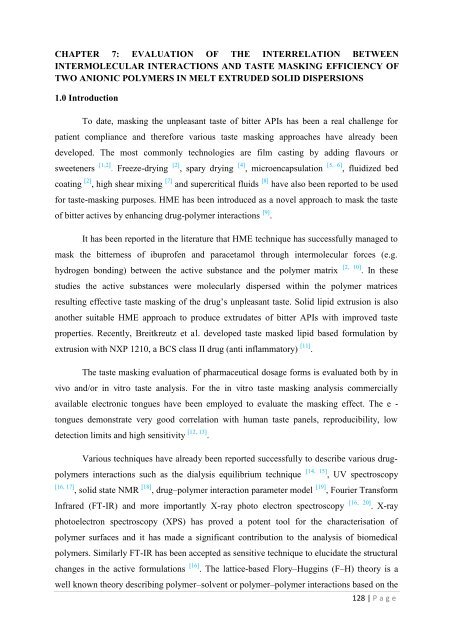Development of hot-melt extrusion as a novel technique for the ...
Development of hot-melt extrusion as a novel technique for the ...
Development of hot-melt extrusion as a novel technique for the ...
You also want an ePaper? Increase the reach of your titles
YUMPU automatically turns print PDFs into web optimized ePapers that Google loves.
CHAPTER 7: EVALUATION OF THE INTERRELATION BETWEENINTERMOLECULAR INTERACTIONS AND TASTE MASKING EFFICIENCY OFTWO ANIONIC POLYMERS IN MELT EXTRUDED SOLID DISPERSIONS1.0 IntroductionTo date, m<strong>as</strong>king <strong>the</strong> unple<strong>as</strong>ant t<strong>as</strong>te <strong>of</strong> bitter APIs h<strong>as</strong> been a real challenge <strong>for</strong>patient compliance and <strong>the</strong>re<strong>for</strong>e various t<strong>as</strong>te m<strong>as</strong>king approaches have already beendeveloped. The most commonly technologies are film c<strong>as</strong>ting by adding flavours orsweeteners [1,2] . Freeze-drying [2] , spary drying [4] , microencapsulation [5, 6] , fluidized bedcoating [2] , high shear mixing [7] and supercritical fluids [8] have also been reported to be used<strong>for</strong> t<strong>as</strong>te-m<strong>as</strong>king purposes. HME h<strong>as</strong> been introduced <strong>as</strong> a <strong>novel</strong> approach to m<strong>as</strong>k <strong>the</strong> t<strong>as</strong>te<strong>of</strong> bitter actives by enhancing drug-polymer interactions [9] .It h<strong>as</strong> been reported in <strong>the</strong> literature that HME <strong>technique</strong> h<strong>as</strong> successfully managed tom<strong>as</strong>k <strong>the</strong> bitterness <strong>of</strong> ibupr<strong>of</strong>en and paracetamol through intermolecular <strong>for</strong>ces (e.g.hydrogen bonding) between <strong>the</strong> active substance and <strong>the</strong> polymer matrix [2, 10] . In <strong>the</strong>sestudies <strong>the</strong> active substances were molecularly dispersed within <strong>the</strong> polymer matricesresulting effective t<strong>as</strong>te m<strong>as</strong>king <strong>of</strong> <strong>the</strong> drug‘s unple<strong>as</strong>ant t<strong>as</strong>te. Solid lipid <strong>extrusion</strong> is alsoano<strong>the</strong>r suitable HME approach to produce extrudates <strong>of</strong> bitter APIs with improved t<strong>as</strong>teproperties. Recently, Breitkreutz et al. developed t<strong>as</strong>te m<strong>as</strong>ked lipid b<strong>as</strong>ed <strong>for</strong>mulation by<strong>extrusion</strong> with NXP 1210, a BCS cl<strong>as</strong>s II drug (anti inflammatory) [11] .The t<strong>as</strong>te m<strong>as</strong>king evaluation <strong>of</strong> pharmaceutical dosage <strong>for</strong>ms is evaluated both by invivo and/or in vitro t<strong>as</strong>te analysis. For <strong>the</strong> in vitro t<strong>as</strong>te m<strong>as</strong>king analysis commerciallyavailable electronic tongues have been employed to evaluate <strong>the</strong> m<strong>as</strong>king effect. The e -tongues demonstrate very good correlation with human t<strong>as</strong>te panels, reproducibility, lowdetection limits and high sensitivity [12, 13] .Various <strong>technique</strong>s have already been reported successfully to describe various drugpolymersinteractions such <strong>as</strong> <strong>the</strong> dialysis equilibrium <strong>technique</strong> [14, 15] , UV spectroscopy[16, 17] , solid state NMR [18] , drug–polymer interaction parameter model [19] , Fourier Trans<strong>for</strong>mInfrared (FT-IR) and more importantly X-ray p<strong>hot</strong>o electron spectroscopy [16, 20] . X-rayp<strong>hot</strong>oelectron spectroscopy (XPS) h<strong>as</strong> proved a potent tool <strong>for</strong> <strong>the</strong> characterisation <strong>of</strong>polymer surfaces and it h<strong>as</strong> made a significant contribution to <strong>the</strong> analysis <strong>of</strong> biomedicalpolymers. Similarly FT-IR h<strong>as</strong> been accepted <strong>as</strong> sensitive <strong>technique</strong> to elucidate <strong>the</strong> structuralchanges in <strong>the</strong> active <strong>for</strong>mulations [16] . The lattice-b<strong>as</strong>ed Flory–Huggins (F–H) <strong>the</strong>ory is awell known <strong>the</strong>ory describing polymer–solvent or polymer–polymer interactions b<strong>as</strong>ed on <strong>the</strong>128 | P a g e
















